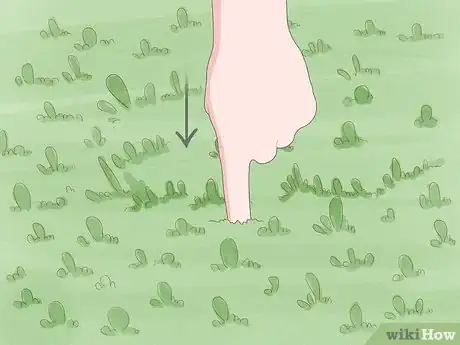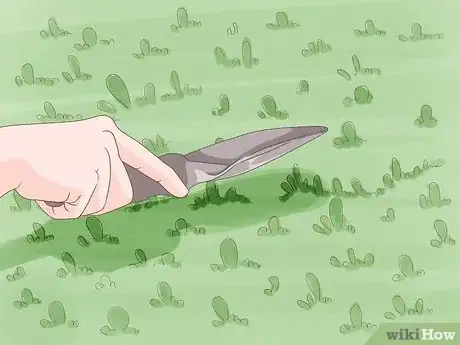This article was co-authored by Jeremy Yamaguchi. Jeremy Yamaguchi is a Lawn Care Specialist and the Founder/CEO of Lawn Love, a digital marketplace for lawn care and gardening services. Jeremy provides instant satellite quotes and can coordinate service from a smartphone or web browser. The company has raised funding from notable investors like Y Combinator, Joe Montana, Alexis Ohanian, Barbara Corcoran and others.
This article has been viewed 40,363 times.
Thatch is the layer of dead grass, roots, and leaves between the grass and the soil. Thatch is important for drainage and moisture retention, but thatch that gets too thick is bad for the grass. Perform a few simple tests to see whether or not your thatch has gotten too thick. A general rule is that thatch should be less than ¾ inch (1.9 cm) thick.
Steps
Checking for a Spongy Thatch
-
1Walk on the lawn to see if it feels firm or spongy. The first thing that gives you a hint at whether or not your lawn needs to be dethatched is the feel of it. Walk around for awhile and see if the ground feels firm. If it feels spongy, or almost bouncy, that’s a sign that the thatch has gotten too thick.
- If you don’t mind the feeling, walk around barefoot to get an even better feel of the firmness of the ground.
- If the ground feels firm under the grass, then the thatch is probably about the right thickness and doesn’t need to be dethatched.
-
2Press the lawn with your hand. If walking around the lawn doesn’t give you a good idea about the firmness, use your hand to check it. Push the grass down until you feel the thatch. Your hand is more sensitive to the spongy feeling than your feet are, so judge whether it feels too thick.[1]
- If your hand reaches the top of the thatch layer and you can obviously push down more, you might want to dethatch the lawn. If it feels firm, don’t worry about it for now.
Advertisement -
3Measure the depth of the thatch with your finger. While you are bent down, gently push your finger through the thatch layer. Pay attention to how far up your finger the thatch goes. Pull your finger out and measure the depth. Less than half an inch (1.3 cm) is the ideal depth.[2]
- If you don’t feel comfortable sticking your finger into the thatch, use a stick or even a ruler to penetrate the thatch layer.
- If the thatch is obviously thicker than ¾ inch (1.9 cm), it’s definitely time to dethatch the lawn.
Performing a Turf Wedge Test
-
1Grab a spade or trowel shovel. A quick and easy test is to dig up a chunk of the lawn turf and actually look at a side view of the thatch layer. Grab whatever kind of shovel or hoe that you have and take it to the portion of lawn you want to check.[3]
- If you have a trowel, this works fine because you only need to look at a small wedge of turf.
-
2Dig out a wedge of turf. Work the shovel into the ground making sure you get down to the soil level. Cut a circle of turf out of the ground so you can pull it up completely out of the ground. There is no need to take out a large chunk, just enough to see the grass, the thatch, and the soil.
-
3Use a ruler to measure the thickness of the thatch. Hold the chunk of turf up so you can see it. Pull it off of the shovel by the grass or simply examine it on the shovel. Hold a ruler or measuring tape up to the thatch. Hold the zero mark right at the top of the soil. If the thatch goes past ¾ inch (1.9 cm), it’s a good idea to dethatch the lawn.[4]
- If you have a large lawn and some time, it’s worth checking a few distinct sections of the lawn. You may not need to detach the entire lawn, and doing a few tests will save you time in the long run.
Dethatching Your Lawn
-
1Run a convex rake through the grass to thin out the thatch. Go to the local hardware or garden store and buy a convex rake used for dethatching. Ask an employee if you aren’t sure which rake to buy. Rake the lawn to pull up most of the thatch layer.[5]
- Have a basic plastic lawn rake on hand, as well, to rake the thatch into a pile for disposal. The dethatching rake is really only to pull it up from under the grass.
-
2Rent a power dethatcher to use on your lawn. For thicker thatch and larger lawns, rent a mechanical dethatcher. It’s a powered machine that digs into the soil to remove thicker thatch. Ask your local equipment rental center to set the machine up before you take it home.[6]
- It’s not too hard to run a dethatcher. You just push it in lines through your lawn. However, the blades need to be set to a certain depth, which is best left to the professionals at the store.
-
3Hire a professional dethatching service. If your thatch is obviously an inch (2.5 cm) or more thick, you’re better off getting a professional to come work on your lawn. If it is in your budget, professionals are able to do a more thorough job than you.
- These services may cost around $250, depending on the size of your lawn.
Expert Q&A
-
QuestionHow often should you dethatch your lawn?
 Jeremy YamaguchiJeremy Yamaguchi is a Lawn Care Specialist and the Founder/CEO of Lawn Love, a digital marketplace for lawn care and gardening services. Jeremy provides instant satellite quotes and can coordinate service from a smartphone or web browser. The company has raised funding from notable investors like Y Combinator, Joe Montana, Alexis Ohanian, Barbara Corcoran and others.
Jeremy YamaguchiJeremy Yamaguchi is a Lawn Care Specialist and the Founder/CEO of Lawn Love, a digital marketplace for lawn care and gardening services. Jeremy provides instant satellite quotes and can coordinate service from a smartphone or web browser. The company has raised funding from notable investors like Y Combinator, Joe Montana, Alexis Ohanian, Barbara Corcoran and others.
Lawn Care Specialist Remove thatch from your lawn when it becomes 1 in (2.54 cm) thick or more. You should also check the growing season of your type of grass because you don't want to de-thatch while your lawn is dormant or not actively growing, which is typically during the winter.
Remove thatch from your lawn when it becomes 1 in (2.54 cm) thick or more. You should also check the growing season of your type of grass because you don't want to de-thatch while your lawn is dormant or not actively growing, which is typically during the winter. -
QuestionHow much does it cost to dethatch your lawn?
 Maggie MoranMaggie Moran is a Professional Gardener in Pennsylvania.
Maggie MoranMaggie Moran is a Professional Gardener in Pennsylvania.
Home & Garden Specialist The price involved to dethatch a yard is dependent on the size of the yard and the thickness of the thatch that needs to be removed. Most services range in price from $200-400 per 1,000 square feet.
The price involved to dethatch a yard is dependent on the size of the yard and the thickness of the thatch that needs to be removed. Most services range in price from $200-400 per 1,000 square feet. -
QuestionHow do you know if your lawn needs aeration?
 Maggie MoranMaggie Moran is a Professional Gardener in Pennsylvania.
Maggie MoranMaggie Moran is a Professional Gardener in Pennsylvania.
Home & Garden Specialist One of the side effects of a clogged yard is standing or spongy grass. This is an indication that the yard needs aeration.
One of the side effects of a clogged yard is standing or spongy grass. This is an indication that the yard needs aeration.
Things You'll Need
- Measuring tape
- Stick or ruler (optional)
- Shovel
- Convex rake
- Plastic lawn rake
- Power dethatcher (rental)
References
- ↑ https://www.bayeradvanced.com/articles/how-to-tell-if-your-lawn-needs-dethatching
- ↑ http://www.gardenmyths.com/dethatching-lawn-thatch/
- ↑ https://www.bayeradvanced.com/articles/how-to-tell-if-your-lawn-needs-dethatching
- ↑ https://www.bayeradvanced.com/articles/how-to-tell-if-your-lawn-needs-dethatching
- ↑ https://www.scotts.com/en-us/library/grass-grass-seed/how-dethatch-aerate-your-lawn
- ↑ https://www.bayeradvanced.com/articles/how-to-dethatch-a-lawn





































































